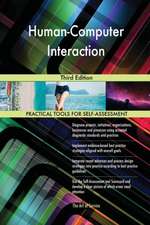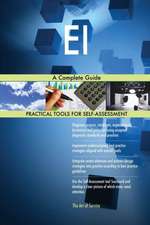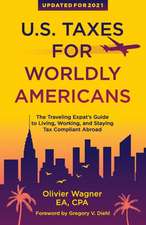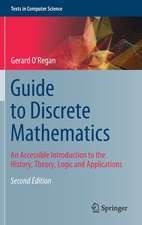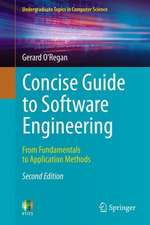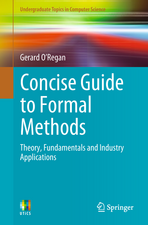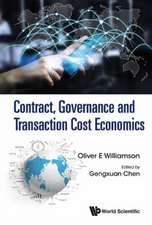A Guide to Business Mathematics
Autor Gerard O'Reganen Limba Engleză Hardback – 25 aug 2022
A Guide to Business Mathematics provides a valuable self-study guide to business practitioners, business students and the general reader to enable them to gain an appropriate insight into the mathematics used in business. This book offers an accessible introduction to essential mathematics for the business field.
A wide selection of topics is discussed with the mathematical material presented in a reader-friendly way. The business context motivates the presentation. The author uses modelling and applications to motivate the material, demonstrating how mathematics is used in the financial sector. In addition to the role of the actuary and the banker, the book covers operations research including game theory, trade discounts and the fundamentals of statistics and probability.
The book is also a guide to using metrics to manage and measure performance, and business economics. Foundations on algebra, number theory, sequences and series, matrix theory and calculus are included as is a complete chapter on using software.
Features
• Discusses simple interest and its application to promissory notes/treasury bills.
• Discusses compound interest with applications to present and future values.
• Introduces the banking field including loans, annuities and the spot/forward FX market.
• Discusses trade discounts and markups/markdowns.
• Introduces the insurance field and the role of the actuary.
• Introduces the fields of data analytics and operations research.
• Discusses business metrics and problem solving.
• Introduces matrices and their applications.
• Discusses calculus and its applications.
• Discusses basic financial statements such as balance sheet, profit and loss and cash account.
• Reviews a selection of software to support business mathematics.
This broad-ranging text gives the reader a flavour of the applications of mathematics to the business field and stimulates further study in the subject. As such, it will be of great benefit to business students, while also capturing the interest of the more casual reader.
About the Author
Dr. Gerard O'Reganis an Assistant Professor in Mathematics at the University of Central Asia in Kyrgyzstan. His research interests include software quality and software process improvement, mathematical approaches to software quality, and the history of computing. He is the author of several books in the Mathematics and Computing fields.
| Toate formatele și edițiile | Preț | Express |
|---|---|---|
| Paperback (1) | 586.97 lei 6-8 săpt. | |
| CRC Press – 25 aug 2022 | 586.97 lei 6-8 săpt. | |
| Hardback (1) | 1389.98 lei 6-8 săpt. | |
| CRC Press – 25 aug 2022 | 1389.98 lei 6-8 săpt. |
Preț: 1389.98 lei
Preț vechi: 1695.10 lei
-18% Nou
Puncte Express: 2085
Preț estimativ în valută:
265.98€ • 274.39$ • 221.96£
265.98€ • 274.39$ • 221.96£
Carte tipărită la comandă
Livrare economică 26 martie-09 aprilie
Preluare comenzi: 021 569.72.76
Specificații
ISBN-13: 9781032311197
ISBN-10: 1032311193
Pagini: 412
Ilustrații: 50 Tables, black and white; 96 Line drawings, black and white; 27 Halftones, black and white; 123 Illustrations, black and white
Dimensiuni: 156 x 234 x 24 mm
Greutate: 0.7 kg
Ediția:1
Editura: CRC Press
Colecția Chapman and Hall/CRC
ISBN-10: 1032311193
Pagini: 412
Ilustrații: 50 Tables, black and white; 96 Line drawings, black and white; 27 Halftones, black and white; 123 Illustrations, black and white
Dimensiuni: 156 x 234 x 24 mm
Greutate: 0.7 kg
Ediția:1
Editura: CRC Press
Colecția Chapman and Hall/CRC
Public țintă
Professional and Undergraduate AdvancedCuprins
1. Introduction to Number Theory. 1.1. Basic Number Theory. 1.2. Fractions and Decimals. 1.3. Prime Number Theory. 1.4. Ratios and Proportions. 1.5. Percentages. 1.6. Review Questions. 1.7. Summary. 2. Algebra. 2.1. Simplification of Algebraic Expressions. 2.2. Simple and Simultaneous Equations. 2.3. Quadratic Equations. 2.4. Indices and Logarithms. 2.5. Exponentials and Natural Logarithms. 2.6. Review Questions. 2.7. Summary. 3. Sets, Relations and Functions. 3.1. Set Theory. 3.2. Relations. 3.3. Functions. 3.4. Review Questions. 3.5. Summary. 4. Sequences, Series and Permutations and Combinations. 4.1 Sequences and Series. 4.2. Arithmetic and Geometric Sequences. 4.3. Arithmetic and Geometric Series. 4.4. Permutations and Combinations. 4.5. Review Questions. 4.6. Summary. 5. Simple Interest and Applications. 5.1. Simple Interest. 5.2. Computing Future and Present Values. 5.3. Promissory Notes. 5.4. Treasury Bills. 5.5. Review Questions. 5.6. Summary. 6. Compound Interest and Applications. 6.1. Compound Interest. 6.2. Present Value. 6.3. Long Term Promissory Notes. 6.4. Equivalent Values. 6.5. Analysing the Business Case for a project. 6.6. Review Questions. 6.7. Summary. 7. Banking and Financial Services. 7.1. Central Bank. 7.2. Retail Banks. 7.3. Financial Instruments. 7.4. Basic Mathematics of Annuities. 7.5. Loans and Mortgages. 7.6. Foreign Exchange. 7.7. Corporate Bonds. 7.8. Review Questions. 7.9. Summary. 8. Trade Discounts and Pricing. 8.1. Calculating Discounts. 8.2. Markups and Markdowns. 8.3. Payment Terms and Cash Discounts. 8.4. Pricing and Pricing Policy. 8.5. Review Questions. 8.6. Summary. 9. Statistics. 9.1. Basic Statistics. 9.2. Frequency Distribution and Charts. 9.3. Statistical Measures. 9.4. Variance and Standard Deviation. 9.5. Correlation and Regression. 9.6. Statistical Inference and Hypothesis Testing. 9.7. Review Questions. 9.8. Summary. 10. Probability Theory. 10.1. Basic Probability Theory. 10.2. Random Variables. 10.3. Binomial and Poisson Distributions. 10.4. The Normal Distribution. 10.5. Bayesianism. 10.6. Review Questions. 10.7. Summary. 11. The Insurance Industry. 11.1. Basic Mathematics of Motor Insurance. 11.2. Basic Mathematics of Health Insurance. 11.3. Basic Mathematics of Pensions. 11.4. The Actuary. 11.5. Review Questions. 11.6. Summary. 12. Data Science and Data Analytics. 12.1. What is Data Science? 12.2. What is Data Analytics? 12.3. Mathematics in Data Science and Analytics. 12.4. Privacy. 12.5. Security. 12.6. Review Questions. 12.7. Summary. 13. Business Metrics and Problem Solving. 13.1. The Goal Question Metric Paradigm. 13.2. The Balanced Scorecard. 13.3. Metrics for an Organization. 13.4. Implementing a Metrics Program. 13.5. Problem-Solving Techniques. 13.6. Review Questions. 13.7. Summary. 14. Matrix Theory. 14.1. Two x Two Matrices. 14.2. Matrix Operations. 14.3. Determinants. 14.4. Eigen Vectors and Values. 14.5. Gaussian Elimination. 14.6. Applications of Matrices. 14.7. Review Questions. 14.8. Summary. 15. Operations Research. 15.1. Linear Programming. 15.2. Cost Volume Profit Analysis. 15.3. Game Theory. 15.4. Queueing Theory. 15.5. Review Questions. 15.6. Summary. 16. Basic Financial Statements. 16.1. Balance Sheet. 16.2. Profit and Loss Account. 16.3. Managing Cash. 16.4. Review Questions. 16.5. Summary. 17. Calculus I. 17.1. Differentiation. 17.2. Integration. 17.3. Review Questions. 17.4. Summary. 18. Calculus II. 18.1. Applications of Calculus. 18.2. Fourier Series. 18.3. The Laplace Transform. 18.4. Differential Equations. 18.5. Review Questions. 18.6. Summary. 19. A Brief Introduction to Economics. 19.1. Macroeconomics. 19.2. Microeconomics. 19.3. Gross Domestic Product. 19.4. Utility. 19.5. Comparative and Absolute Advantage. 19.6. Elasticity of Demand. 19.7. Role of Money. 19.8. Role of Government in the Economy. 19.9. Economic Indicators. 19.10. Competition. 19.11. Globalisation and Terms of Trade. 19.12. Mathematics in Economics. 19.13. Review Questions. 19.14. Summary. 20. Software to support Business Mathematics. 20.1. Microsoft Excel. 20.2. Python. 20.3. Maple. 20.4. Minitab Statistical Software. 20.5. R Statistical Software Environment. 20.6. Mathematica. 20.7. MATLAB. 20.8. Sage Accounting Software. 20.9. SPSS Statistics. 20.10. SQL and Relational Databases. 20.11. SAS. 20.12. Review Questions. 20.13. Summary.
Notă biografică
Dr. Gerard O'Regan is an Assistant Professor in Mathematics at the University of Central Asia in Kyrgyzstan. His research interests include software quality and software process improvement, mathematical approaches to software quality, and the history of computing. He is the author of several books in the Mathematics and Computing fields.
Descriere
This book provides a valuable self-study guide to business practitioners, business students and the general reader to enable them to gain an appropriate insight into the mathematics used in business. This book offers an accessible introduction to essential mathematics for the business field.


